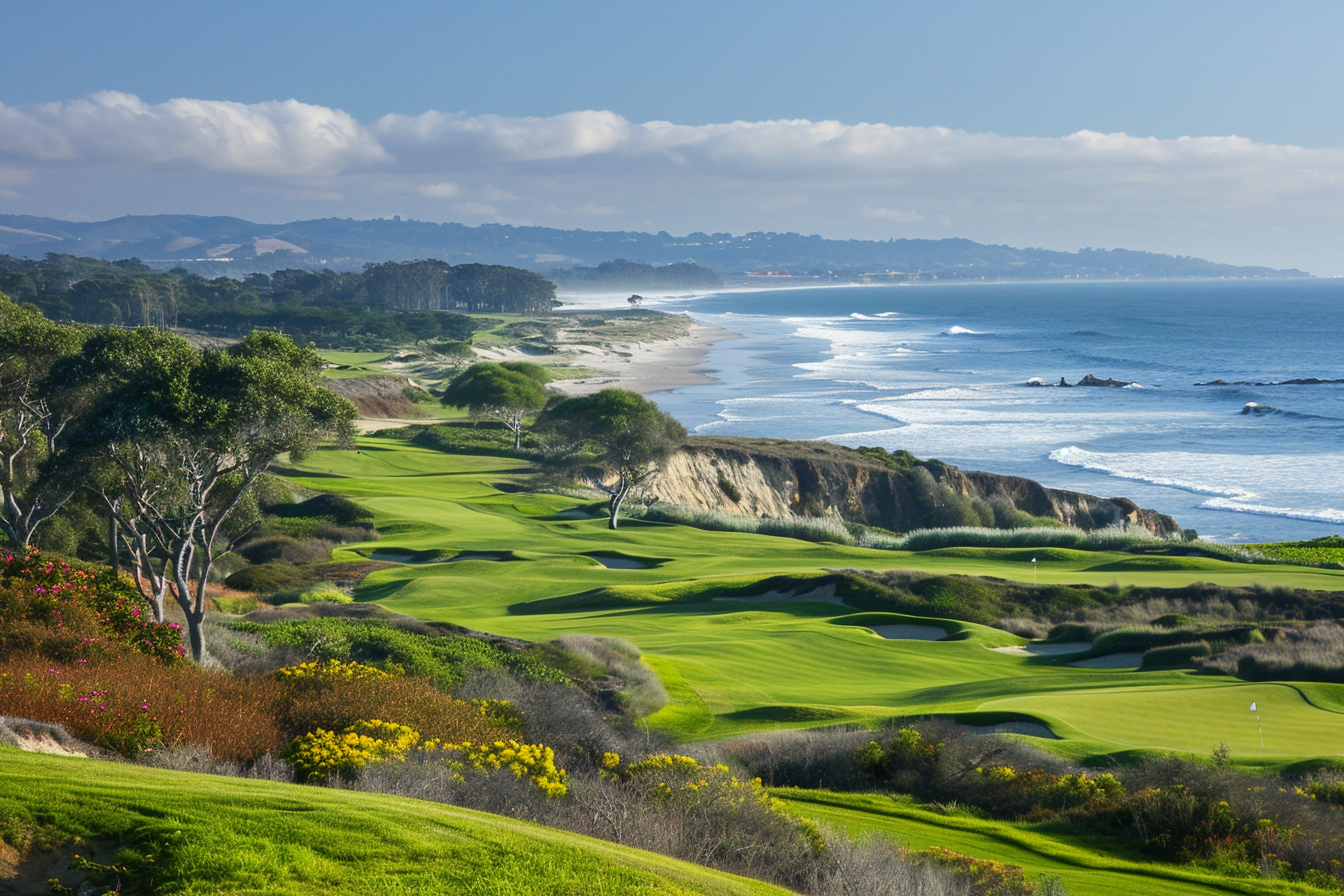
Golf course design is a delicate balance between precision and creativity, where each fairway and green tells a unique story. In this article, we’ll delve into the captivating world of golf course architecture, tracing its historic roots and exploring the innovative techniques shaping its future.
Contents
What is Golf Course Design?

Golf Course Design encompasses the art and science of creating and shaping golf courses to provide challenges, beauty, and strategic elements for players. It combines elements of landscaping, architecture, and environmental considerations to craft unique and engaging courses that test the skills of golfers.
The evolution of golf course design has seen a shift from traditional layouts to more strategic and environmentally conscious approaches, focusing on sustainability and natural integration. Renowned designers like Dana Fry and Jason Straka have made significant contributions, blending innovation with respect for the game’s traditions.
Historical gems like the Iowa Club and Lawsonia showcase the timeless appeal of well-designed courses, with each hole offering a new adventure and strategic puzzle for golfers to solve.
History of Golf Course Design

The History of Golf Course Design traces back to the early roots of the sport, where natural landscapes were utilised for the first courses, evolving into a sophisticated discipline with the introduction of strategic bunkering and design elements. Notable figures such as Seth Raynor and Jack Nicklaus have left indelible marks on the landscape of golf course architecture.
Throughout the decades, the evolution of golf course design witnessed a transition from the traditional parkland-style layouts to the modernist approaches that prioritise sustainability and environmental integration. Environmental consciousness became a significant factor, leading to the creation of eco-friendly courses that harmonise with their surroundings. Architects like Tom Doak and Rees Jones emerged as pioneers in this shift towards more nature-centric designs, blending technical expertise with a profound respect for the land. The partnership of Coore and Crenshaw further elevated the artistry of course design, emphasising minimalist aesthetics and strategic challenges that test a golfer’s skill and decision-making.
Who are the Pioneers of Golf Course Design?
The Pioneers of Golf Course Design, such as Seth Raynor and Jack Nicklaus, revolutionised the industry with their innovative approaches, shaping the way modern courses are constructed and challenging traditional design norms.
One of the key aspects that set Seth Raynor apart was his keen attention to detail and ability to incorporate natural landscapes into his designs seamlessly.
His emphasis on strategic elements, such as bunkering and green complexes, created courses that not only tested players’ skills but also embraced the beauty of the surroundings.
On the other hand, Nicklaus Design, inspired by the great Jack Nicklaus himself, focused on length and strategic play, often incorporating risk-reward features that added excitement to the game. The influence of figures like Dana Fry and Jason Straka further enriched the golf course design landscape, bringing new perspectives and innovative ideas to the forefront.
Factors to Consider in Golf Course Design
When approaching Golf Course Design, several critical factors must be considered to ensure the creation of a successful and sustainable course. These include evaluating the terrain and landscape, understanding the impact of climate and weather, managing budget and resource constraints, and selecting an accessible and strategic location.
Terrain and Landscape
The Terrain and Landscape of a golf course are foundational elements that heavily influence the design process. Designers like Coore Crenshaw course and Tom Doak leverage natural features to create courses that harmonise with the environment and offer a unique playing experience.
When architects consider the terrain and landscape, they aim to blend the course seamlessly into its surroundings, enhancing the beauty of nature rather than imposing man-made elements. Coore Crenshaw, known for their minimalist approach, often opt for strategic routing that works with the natural contours of the land. Tom Doak, on the other hand, emphasises strategic challenges within the landscape, utilising native flora and fauna to create an immersive golfing experience.
Climate and Weather
Climate and Weather considerations are crucial in Golf Course Design, as they directly affect course maintenance, playability, and overall golfer experience.
When crafting a golf course, understanding the local climate is paramount. Weather patterns dictate irrigation needs, turfgrass selection, and even the placement of hazards and bunkers. Designers like Rees Jones utilise innovative strategies such as drought-resistant grasses and strategic water features to combat extreme weather conditions. Courses like Lawsonia, with its rich history, have adapted over time to withstand the elements, making them both challenging and enjoyable for golfers of all skill levels.
Budget and Resources
Budget and Resources are critical components in Golf Course Design, influencing the scope, quality, and sustainability of projects. Designers like Dana Fry and Jason Straka are adept at optimising resources to create high-calibre courses that balance financial constraints with design excellence.
Having a limited budget or insufficient resources can often lead to creative solutions in golf course design. Designers faced with these challenges need to think outside the box and find innovative ways to still deliver top-notch courses. Dana Fry and Jason Straka, for instance, have demonstrated their skill in maximising project outcomes by using cost-effective materials, strategic landscaping techniques, and efficient layout designs.
Accessibility and Location
Accessibility and Location are key considerations in Golf Course Design, as they influence the course’s reach, appeal, and long-term sustainability. Notable courses like Iowa club and Lawsonia have leveraged strategic locations to attract players and enhance the overall golfing experience.
When designing a golf course, the strategic positioning of the course plays a crucial role not only in drawing players but also in creating a memorable experience. The location can significantly impact the design decisions, such as choosing natural features, routing the layout, and planning amenities. Take, for example, courses situated near picturesque landscapes or bodies of water – these locations not only offer stunning views but also challenge players in unique ways.
Types of Golf Courses

Golf Courses come in various Types, each offering a distinct playing experience based on their design, layout, and location. Common types include Links Courses, Parkland Courses, Desert Courses, and Mountain Courses, each presenting unique challenges and scenic beauty.
Links Courses
Links Courses are known for their open, windswept landscapes and natural features, offering a traditional and strategic style of play. Designers like Brandon Johnson and courses like Marbella Club excel in creating authentic links experiences that challenge golfers with unpredictable conditions.
These courses are characterised by their proximity to the sea, sandy dunes, and firm turf, creating a rugged yet picturesque setting for golf enthusiasts. The design elements of links courses often include undulating fairways, pot bunkers, and tall wispy grasses, adding to the challenge and beauty of the layout. Brandon Johnson, known for his innovative approach to course architecture, emphasises the importance of blending the course seamlessly with its natural surroundings, capturing the essence of traditional links golf.
Parkland Courses
Parkland Courses are set amidst lush, wooded landscapes and offer a more manicured and picturesque setting for golfers. Designers like Chris Cochran and courses like Panther National course focus on creating scenic and strategic parkland layouts that appeal to a wide range of players.
The allure of Parkland Courses lies in their ability to seamlessly blend natural beauty with challenging golf experiences. The design choices made by experts in the field elevate these courses to a level where each hole feels like a journey through nature’s pristine canvas. Players can expect to encounter rolling fairways, strategically placed bunkers, and breathtaking views at every turn. Chris Cochran’s philosophy of integrating the course with the existing landscape ensures that the golfers are not just playing a game but embarking on an immersive outdoor adventure.
Desert Courses
Desert Courses present a unique challenge with their arid landscapes, rugged terrain, and strategic design elements that blend seamlessly with the natural surroundings.
These courses often feature rolling dunes, native vegetation, and stunning panoramic views that add to the overall allure of the golfing experience. Designers put a premium on sustainability, utilising innovative irrigation methods to minimise water usage while maintaining the course’s playability and aesthetic appeal. Bryce Swanson, known for his minimalist approach, intricately weaves the course layout into the desert terrain, creating a harmonious balance between challenging holes and environmental conservation. Similarly, historic courses like Lawsonia embrace the natural topography, incorporating natural hazards and unique features to challenge golfers of all skill levels.
Mountain Courses
Mountain Courses offer breathtaking views, elevation changes, and strategic challenges that make them a favourite among golfers seeking a unique playing experience. Designers like Mike Clayton and courses like the Norwegian club craft mountain layouts that blend seamlessly with the natural alpine environment.
One of the key attractions of mountain courses is their ability to offer golfers a truly immersive experience, surrounded by stunning vistas and the rugged beauty of the landscape. The terrain itself presents a canvas for designers to create layouts that not only showcase the natural surroundings but also provide golfers with exciting and strategic gameplay.
Mike Clayton, known for his adeptness at integrating course design with topography, has emphasised the importance of preserving the integrity of the land when creating mountain courses. This approach ensures that the course harmonises with its surroundings, enhancing the overall experience for players.
What Makes a Well-Designed Golf Course?
A Well-Designed Golf Course incorporates Key Elements that enhance the playing experience, strategic depth, and aesthetic appeal for golfers. These elements include Strategic Bunkering, Natural Hazards and Obstacles, Variety of Hole Lengths and Layouts, and Scenic Views that elevate the overall enjoyment of the course.
Strategic Bunkering
Strategic Bunkering plays a pivotal role in Golf Course Design by adding challenge, visual interest, and strategic decision-making for golfers. Designers like Seth Raynor and firms like Nicklaus Design are revered for their innovative bunker placements that test even the most skilled players.
Strategic Bunkering is not just about designing bunkers randomly across the course; it involves a meticulous planning process to enhance the strategic complexity of each hole. Architects like Raynor understood that bunkers could serve as both visual cues and strategic obstacles on the course, guiding players to make critical decisions. Their designs often feature bunkers strategically placed to tempt risky shots or punish errant ones. Courses such as Fishers Island Club in New York and Shoreacres in Illinois showcase how well-executed bunkering can elevate the strategic gameplay, making them memorable and challenging for golfers of all levels.
Natural Hazards and Obstacles
Natural Hazards and Obstacles are integral components of Golf Course Design, adding excitement, challenge, and character to the playing experience. Designers like Rees Jones and institutions like Culver Academies leverage natural elements to create memorable obstacles that require strategic thinking from golfers.
These hazards, ranging from rugged terrains to water bodies, force golfers to adapt their strategies and carefully plan their shots. Challenging terrain such as undulating fairways or strategically placed bunkers not only test players’ skills but also enhance the overall aesthetic appeal of the course. Architects like Rees Jones are renowned for their skill in harmonising man-made features with the existing natural landscape, ensuring that the course feels both challenging and visually stunning.
Institutions such as Culver Academies take a holistic approach, integrating natural features like trees, lakes, and slopes seamlessly into the course design. By doing so, they offer players a unique and immersive golfing experience that encourages them to appreciate the beauty and unpredictability of nature while honing their skills.
Variety of Hole Lengths and Layouts
A Variety of Hole Lengths and Layouts is essential in Golf Course Design to provide diversity, challenge, and strategic engagement for players of all skill levels.
By incorporating a range of hole lengths, designers can cater to varying levels of skill and playing styles, ensuring that the course remains exciting and fair for everyone. This diversity keeps players engaged and eager to tackle new challenges with every round. The strategic placement of hazards and obstacles by experts like Dana Fry adds an element of thought and decision-making to each shot, forcing golfers to carefully plan their approach.
Scenic Views
Scenic Views are a hallmark of exceptional Golf Course Design, offering players breathtaking vistas, natural beauty, and immersive environments that enhance the overall golfing experience. Designers like Chris Cochran and innovations like the Durabunker system prioritize scenic elements to create visually stunning and memorable courses.
In the world of golf course aesthetics, scenic views play a pivotal role in captivating the players’ senses and adding an extra layer of enjoyment to their game. The strategic placement of Scenic Views not only provides a visual treat but also serves functional purposes, such as aiding in determining the distances and planning shots. By incorporating elements of nature seamlessly into the course design, designers like Cochran create a harmonious balance between the man-made structures and the surrounding landscape.
The Role of Technology in Golf Course Design
The Role of Technology in Golf Course Design has evolved significantly, with advancements in digital mapping, simulation software, and construction techniques revolutionising how courses are planned, built, and maintained. Innovations in irrigation systems, turf management, and environmental monitoring have also contributed to the sustainability and efficiency of modern golf facilities.
These technological advancements have not only enhanced the playability and aesthetics of golf courses but also improved resource management and overall environmental impact. Courses can now be meticulously designed using precise data and computer-aided modelling, allowing architects to create intricate layouts that challenge and delight players. The implementation of smart irrigation systems and specialised turf care technologies has minimised water wastage and chemical usage, promoting eco-friendly practices.
- Some notable examples of cutting-edge solutions in golf course design include the minimalistic and sustainable approach taken by Sand Valley Golf Resort in Wisconsin, known for its natural contours and strategic bunkering.
- The futuristic design of Top of the Rock Golf Course in Missouri, complete with waterfalls and caves, showcases how technology can blend seamlessly with nature to create a unique golfing experience.
Sustainability in Golf Course Design
Sustainability in Golf Course Design is a growing priority, with designers and developers focusing on eco-friendly practices, water conservation, and habitat preservation to create courses that harmonise with the environment. Implementing renewable energy sources, native landscaping, and responsible water usage are key initiatives driving the sustainability movement in golf course construction.
Considering the impact of traditional golf course development on the ecosystem, more golf facilities are now striving to embrace sustainable principles. By incorporating green building techniques, such as permeable paving and rainwater harvesting systems, these courses can significantly reduce their environmental footprint. Notable examples like the Audubon-certified TPC San Antonio showcase how a commitment to sustainable design can enhance both the golfing experience and conservation efforts simultaneously.
The Future of Golf Course Design
The Future of Golf Course Design is poised for exciting developments, with a focus on technological integration, sustainability, and enhancing the player experience through innovative designs. Embracing data analytics, virtual reality simulations, and community engagement will likely shape the next generation of golf courses, creating dynamic and immersive environments for golfers of all levels.
Plus the integration of advanced technologies, the future of golf course design may also see a greater emphasis on sustainability practices. Environmental conservation and resource efficiency are becoming key considerations in layout planning and maintenance. Courses could implement eco-friendly irrigation systems, utilise native landscaping to promote biodiversity, and explore renewable energy sources for power needs.
There may be a shift towards more customisable and flexible designs to cater to the diverse preferences of modern golfers. By incorporating modular features and interactive elements, courses could adapt to different skill levels, event requirements, and changing trends in the sport.
Frequently Asked Questions
What is golf course design?
Golf course design is the process of planning and creating a golf course, including the layout and placement of holes, hazards, and other features. It takes into account factors such as terrain, climate, and budget to create a challenging and enjoyable course for players.
What are the key elements of a well-designed golf course?
A well-designed golf course should have a variety of holes that test different aspects of a player’s game, such as driving, chipping, and putting. It should also have a good balance of hazards, such as bunkers and water, to provide a challenge without being too difficult. The layout should also take advantage of the natural features of the land to create a visually appealing course.
Why is proper drainage important in golf course design?
Proper drainage is crucial in golf course design to prevent water buildup and maintain playable conditions. Without adequate drainage, water can accumulate on the course, making it difficult for players to navigate and causing damage to the turf. This can also lead to costly repairs and maintenance in the long run.
How do architects plan for different skill levels in golf course design?
Architects take into consideration the skill levels of different players when designing a golf course. This may include incorporating multiple tee boxes to accommodate players of various abilities, as well as creating a variety of hole designs to challenge both beginners and experienced players.
What factors should be considered when choosing a golf course designer?
When choosing a golf course designer, it is important to consider their experience, reputation, and style. Look for a designer who has a track record of successful projects and understands the local environment and climate. It’s also helpful to view their portfolio and speak with other courses they have designed to get a sense of their design philosophy.
Can a golf course design be environmentally friendly?
Yes, golf course design can be environmentally friendly by incorporating sustainable practices, such as using native plants, conserving water, and minimising the use of pesticides and chemicals. These practices not only benefit the environment but also improve the overall playing experience for golfers.

